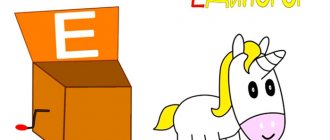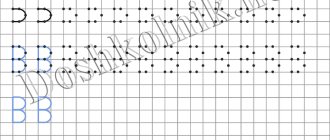Literacy lesson. Sound [ts], letters Ts, ts
Topic: sound [Ts], letters Ts ts.
Goals:
1) introduce the sound [ts], letters Ts ts, teach to read words with a new letter
2) develop phonemic hearing, attention, memory
3) cultivate respect for people of different professions, interest in circus professions.
1. Organizational moment.
2. Repetition. Speech warm-up
a) reading the sound series of vowels (whispering, out loud, loudly, etc.) a, o, u, i, y, e
b) reading syllables according to the table
c) repetition of the studied quatrains
d) pure speech (teacher reads, children repeat)
Tset-tse-tse, tsetse-tse Here's a fairy tale about an egg, Tso-tso-tso, tso-tso-tso The chicken laid an egg Tsu-tsu-tsu, tsu-tsu-tsu Pussy reaches for the egg Tsa-tsa- tsa, tsa-tsa-tsa Shoot, kitten, from the egg! Tsu-tsu-tsu, tsu-tsu-tsu Don't let him near the egg! Tso-tso-tso, tso-tso-tso We'll eat the egg ourselves. Well done! Tset-tse-tse, tset-tse-tse Here's a fairy tale about an egg,
-Which sound was pronounced and heard more often than others? ([C])
-Today we will get acquainted with this new sound and letters.
3. Message of the topic, purpose of the lesson.
4. Conversation about blacksmiths (Goretsky “Russian ABC”).
5. Syllable-sound analysis of the word KUZNETS.
- sound characteristics [Ts] (always dull, always hard)
6. Sound audibility exercise.
We learned a lot of letters, we got to the letter c. There are words where c is at the beginning, where in the middle, where at the end. A chain, a flower and a number - here C at the beginning will be read by everyone, And in the words father, fighter C we write at the end. A heron walks through the swamp Her chicks are waiting in the nest The circus will open on Saturday The wrestlers have already arrived The young blacksmiths have come to work in the workshop There is a letter c in every line, Like a pebble in a ring. And on each page there are, On the border and in the capital, And in the chickens on the porch There are also two letters Ts. (L. Dyakonov)
-name words with the sound [ts].
7. A story about numbers (G. Yudin “Bukvarenok”).
How old are you? How many friends do you have? How many paws does a cat have? To calculate all this, you need to know the numbers. And what did the ancient people who did not know them think? They tied knots on a string and made notches on a stick or stone, and the simplest counting was done on their fingers. Instead of “five” they said “hand”, instead of “fifteen” they said “two arms and one leg”, and when they said “the whole person” it meant twenty. Then in Ancient India they invented icons to depict numbers - a circle or a zero; the Arabs called it “sifra”, which is how the word “digit” appeared. We still use slightly modified Arabic numerals. Mathematicians are called the “queen of all sciences.” If you learn it, you will become a “king”.
8. Introducing the letters Tsts.
9. Reading syllables. Words (p. 175 “Russian alphabet”).
-Remember the words in which the syllable tsa (tso, tsy, tsu) occurs. 10. Conversation on the illustration “CIRCUS”
10. Conversation on the illustration “Circus”.
- a story about a circus.
In ancient Roman times, a circus was a long track for speed competitions. The performance with riders, trained animals, acrobats and clowns, which we call a circus, appeared much later. It arose in 1768, when retired English cavalryman Philip Astley fenced off a round open-air area with a rope and began charging money from those who wanted to see his horsemanship. The enterprise turned out to be successful, and he soon attracted other performers and built an indoor arena. The basis of the first performances were equestrian performances.
Traveling tent circuses appeared around 1830 and gradually turned into grandiose spectacles.
11. Finding the letter C in proverbs.
12. Logic exercises.
1) Continue the series of words (on the board) WOLF-WOLF BEAR-FOX-HARE-
2) If there is more than one people or objects, we say: fingers, dances, wells, ends, fathers, Indians, cucumbers, buttons, onions, singers, lollipops, Germans - But what do we call them if there is only one person or object? ?
13. Learning a poem.
Heron explains. The heron, standing on the porch, explains the letter c: -Come, little chicken! Repeat: chick, chick, chick! If you learn your lesson, I'll give you a flower. (G. Satir)
14. Lesson summary.
-Which letter did we meet today?
-Look at the pictures and name words that have the sound [ts].
Lesson topic: “The sound [ts] and its designation by the letters Ts, ts”
Goals:
- Educational:
- teach how to identify the sound [ts] in words and pronounce it correctly; introduce the letters Ts, ts;
- teach them to read syllables, words, sentences, promote the development of phonemic hearing;
- enrich students' vocabulary; carry out preparatory work on the development of spelling vigilance.
- Educational: to cultivate a caring attitude towards nature.
- Developmental: develop thinking, memory, imagination, interest in the subject.
Is the letter “ts” soft or hard? Russian language rules
Nowadays, many people show interest in their past, including the history of their family. Interest in this topic did not arise by chance: the idea of oneself as a person has changed. If earlier a person was part of a system, today he is, first of all, an individual. Therefore, the question of where I and my ancestors are from is very relevant.
You can, oddly enough, slightly lift the veil of secrecy by studying the rules of the Russian language and the letter “C”. Why, for example, is it written “Yeltsin”, but “Solzhenitsyn”, if, according to the rule, “I” follows “C”, with the exception of a few words. It’s simple: this law does not apply to the writing of surnames, since they were entered into the passport in accordance with the pronunciation that existed in the territory of the person’s residence. In Ukraine it was considered correct to write “TSI”, and in Russia - “CI”. From which it becomes clear where, whose ancestors are.
Pronunciation problems
Due to the complexity of the structure of the sound “C”, children often have difficulties with reproduction. They are usually divided into the following types:
-
The phoneme is pronounced with an incorrect position of the tongue. The organ is protruded between the front and upper incisors. The sound turns out to be lisping.
Interdental. - Prizubny
. The tip of the tongue focuses on the central incisors. The organ rests equally on the upper and lower teeth. This position forms a bow. An air stream passes through it as you exhale. Receives a hard or soft “T” (princess - Tarevna or Tyarevna). - Labial-dental. The organs of the articulatory apparatus take a position characteristic of the phoneme “C”. The lower lip is raised. A small gap forms between the incisors. An air stream comes out through it. It turns out that “C” is replaced by “S” or “F” (king - Sar or Far).
- Hissing. The tongue is pulled back. The speech organ lies at the bottom of the oral cavity. It tenses up when pronouncing. Its back reaches towards the sky. The air stream comes out through the gap between the back and the sky. A sound similar to a soft “Sh” is formed (chain - Shep).
- Whistling. The sound "C" is replaced by "S". The organs of speech are in the appropriate position. The tip of the tongue rests on the lower incisors. There is a notch on the back of the organ. An air stream passes through it, forming the sound of the phoneme “C”.
- Side. The tip of the speech organ touches the alveoli (the area behind the upper incisors). In this case, the tongue itself can be tilted in any direction. The air stream comes out in accordance with the position of the organ. Also, with lateral pronunciation, air can escape equally from both sides, as with the sound “L”.
- Nasal.
The defect occurs due to improper breathing. When you exhale, air passes through the nasal passages. The tongue tenses. The tip is pulled back. The organ is located at the bottom of the oral cavity. “X” sounds with a nasal tint (heron-XNaplya).
Important!
to independently determine what defect a baby has. Therefore, it is recommended to seek help from a specialist. To choose the right correction technique. In speech therapy, a whole file of tasks , each of which takes into account the age indicators and abilities of the child.
Sound and noise
The number of consonant letters in the Russian language is 21. One part of them is pronounced with the participation of voice and noise, and the other - only with the participation of noise. Accordingly, the first part refers to voiced consonants, and the second, accordingly, to voiceless consonants.
The next characteristic by which consonant letters are divided is hardness and softness, which depend on the vowel letter following the consonant in the syllable.
- If you try to shout out the letters: k, p, s, t, f, x, c, w, then you will have difficulties, since their articulation does not involve the participation of the voice: all these letters are voiceless. Elementary school teachers suggest memorizing the sentence: “Styopka, do you want some bacon? Fi!”, which contains the entire set of voiceless consonants. But they are wonderfully pronounced in a whisper.
- But you can easily shout out the letters: b, c, d, d, g, z, j, l, m, n, r, since their pronunciation involves sound vibrations formed by ligaments and changed through articulation. These are voiced consonants. But if you try to whisper them, you won’t succeed.
In colloquial speech, voiced and voiceless consonants can be pronounced almost identically: live - sew; goal - count; day is a shadow, but their meanings do not coincide.
Sounds and letters. Consonants
Good afternoon, my friends.
Today we will continue the conversation about sounds and letters
.
The last lesson was devoted to vowel sounds. What do you know about them?
Remember:
vowels in Russian
, but 6
vowel sounds
.
* Vowel sounds
consist only of voice.
* When we pronounce vowel sounds
, air passes through the mouth freely, without obstructions.
* Vowel sounds
You can easily pull and sing.
* Vowel sounds
form syllables.
* Vowel sounds
There are stressed and unstressed.
Now look at the alphabet. Those letters that are indicated in blue are called consonants
. And now we will figure out how they differ from vowels.
How many consonant letters are there in the Russian alphabet?
One, second, third, fourth. Count for yourself... So, there are twenty-one consonant letters
.
But
there are a lot more
consonant sounds thirty-six
.
Although some scientists claim that there are not even thirty-six, but thirty-seven. But for now we will assume that there are thirty-six of them. We'll talk about why there are more consonant sounds than letters a little later. Now let's figure out what consonants consist of
. Vowels, as we already know, consist of voice. A-a-a, o-o-o, o-o-o, e-i-i, e-e-e, e-e-e. What about the consonants? Let's try to pronounce some of them: B, V, G, D, P, R, T, S, Sh. Do you hear? Some sounds are made using voice and noise, while others are made only using noise. At the same time, air has difficulty breaking through the barrier. Such an obstacle can be lips, teeth, tongue, and even a slightly constricted throat.
This means that consonant sounds consist of voice and noise or only noise
.
If consonant sounds are pronounced with the help of voice and noise, then they sound loud: [b], [c], [g], [d], [g], [z]. That's what they're called - voiced consonants
.
If consonant sounds are pronounced only with the help of noise, then they sound dull: [p], [f], [k], [t], [sh], [s]. That's what they call them - voiceless consonants
.
There are pairs of consonant sounds, when pronounced, the mouth makes the same movements. They pressed their lips together, and then abruptly tore one from the other and exhaled air. And so we pronounced the sound [p]. And if you add a voice, you get the sound [b].
[b] and [p] – paired consonants
. They are designated by the letters Be and Pe. And the consonants Ve, eF, Ge, Ka, De, Te, Zhe, Sha, Ze, Es are also paired.
But the voiced consonants, designated by the letters El, EM, EN, Er, And the short and voiceless consonants Ha, Tse, Che, Shcha, do not have pairs. That is, they are unpaired in terms of voicedness and deafness.
.
When we pronounce consonants
, the air meets a barrier in the mouth - lips, teeth, tongue. Some consonants can be pulled. RRRRRR, SSSSSS, JJJJJJ. But still, the air does not come out of the mouth freely, without obstacles.
Can consonant sounds
form syllables on your own?
We already know that syllables form vowel sounds
. But those who agree can help them. Each syllable must have one vowel sound, but there may be no consonants at all, as, for example, in the words ukha, wasp. Or a syllable may have one or more consonants, as in the words neighborhood, happy.
This means that consonant sounds can only form a syllable together with a vowel
.
Well, now let’s figure out why there are so many more consonant sounds than letters.
Let's take a couple of words: bow and hatch. What is the first sound in the word onion? Of course, firmly - [l]. But in the word hatch, the first sound is soft – [l']. This means that one letter El can mean two sounds - a hard sound [l] or a soft sound [l']. Both hard and soft sounds can be sounds designated by the letters Be, Ve, Ge, De, Ze, Ka, el, em, eN, pe, eR, Es, Te, eF, Ha.
If after a consonant there are letters e, e, yu, i or ь
, then the consonant sounds soft.
As in the words hatch, crumpled, rice, maple, stranded.
And if after a consonant there are the letters a, o, u, e, s or another hard consonant
, then the consonant sounds hard
.
For example, bow, small, rat, bow, mayor, table. We can say that consonant sounds can be paired in terms of hardness and softness
.
But not all consonants can be both hard and soft. Consonant sounds [zh], [sh], [ts] always sound hard
, no matter what vowel is behind them.
I hope you haven't forgotten? In Russian, ZHI-SHI is written with the letter I, ZHE-SHE, CE are written with the letter E. After the letter C, I or Y is written in different words. But at the same time, the sounds [zh], [sh], [ts] still remain solid.
Listen to how words sound with these combinations: lived, sewed, tin, six, center, circus, chicken.
But the consonants [th], [ch] and [sch] are always soft
. I'm sure you all know the rule: CHA-SCHA is written with the vowel A, CHU-SCHU is written with the vowel U, CHK-CHN is written without a soft sign. But in all these combinations, the sounds [ch] and [sch] sound soft.
thicket, stocking, pike, hummock, night.
From all that has been said, we can conclude that the consonants zh, sh, ts, y, ch, shch do not have a pair for hardness and softness.
Well, here you and I remembered about consonant sounds
everything that you were familiar with in the first and second grades.
And now I will tell you how you can characterize the consonant sounds in a word
.
For example, the word “bunny”.
As you can see, it has five letters. But only three of them are consonant.
The first sound is [z]. He agrees. I’ll say it again [z]. He's solid. It is pronounced [z] with the help of noise and voice, that is, it sounds loud. So he is loud. It can have a pair in terms of sonority-dullness, and in hardness-softness. That’s why I say: “Double.”
Consonant sound [th']. Soft, sonorous, unpaired.
Consonant sound [k]. Hard, dull, steamy.
Now let’s take the word “row”.
The first sound [r'] is a consonant, soft, voiced, unpaired in terms of voicedness and deafness.
But at the end of the word “row” the letter D is written, but the sound [t] is pronounced. After all, we do not say [row], but [ryaT]. Therefore, there is a sound [t]. It is consonant, hard, deaf, paired.
Well, that’s probably all I wanted to talk about today.
Now it remains to summarize this lesson. So how do consonants differ from vowels?
* The Russian language has 21 consonants, but 36 consonant sounds
.
* Consonants
consist of voice and noise or only noise.
Sounds consisting of voice and noise are called voiced
, and those sounds that consist only of noise are called
voiceless
.
* When we pronounce consonant sounds, the air meets a barrier in the mouth (lips, teeth, tongue).
* Some consonant sounds can be pulled out, but the barrier in the mouth remains.
* Consonant sounds together with a vowel can form a syllable
.
And don't forget.
The softness of a consonant sound in writing is indicated by the vowels e, e, yu, i, and or the letter ь
(soft sign).
The exception is words with the combinations zhi-shi, zhe-she, qi - tse, in which the consonants sound firmly.
The hardness of a consonant sound in writing is indicated by the vowels a, o, u, e, s, or another hard consonant
.
The exception is words with the combinations cha-sha, chu-schu, chk-chn, in which the consonant sounds soft.
Well, don’t forget how to correctly characterize consonant sounds
.
And now it's time to say goodbye. Goodbye, my dear friends!
Pairs and "non-pairs"
It is necessary to find out whether the unvoiced letter “c” can be hard or soft. We have a group of unpaired letters. These are th, x, l, ts, m, ch, n, shch, r, some of which correspond to soft pairs, and some are only such consonant letters.
These are consonants called sonors in Russian: [й'], [л], [л'], [м], [м'], [н], [н'], [р], [р']. The upper palate takes part in their pronunciation.
There is no letter “c” among them.
The remaining part consists of letters whose pronunciation is associated with hissing: [x], [x'], [ts], [ch'], [sch']. Of these, one letter is paired according to the softness-hardness principle, two letters can only be soft - “ch” and “sch”, and the fourth letter does not have a pair according to softness, and is accordingly hard.
The question of whether the letter “ts” is soft or hard has been resolved: the hissing letter “ts” in Russian can only be hard.
The letter "C" and its pronunciation
So, the letter “C” does not form a pair, therefore, it refers to unpaired, voiceless consonant letters. If we look at the pronunciation of the letter “ts”, it turns out that it consists of two sounds: [t] and [s], which in total sounds like [ts]. In Russian, “ts” exists only in a hard form.
There are some minor differences in the pronunciation of words starting with the letter “c” in cases of its combination with the vowels [a], [o], [u] behind it, and with the vowels [e], [i]. In the syllables tsa, tso, tsu the letter “ts” sounds hard, and in the syllables tse, qi it sounds somewhat softer. The same applies to words in which these syllables are in the middle.
In some words that came to us from other languages, there is a double letter “c”, but this word is pronounced as if it only has one “c”. However, in such cases, the emphasis is placed on the sound [t] that makes up the letter “ts”. Let's take the word that came to us from Italy, “pizzicato”: it should be pronounced not [pi, ts, tsikato], but [pi, t.sicato].
The pronunciation of words with a combination of the letters “t” and “c” (saints) follows the same principle.
How to teach children to distinguish between hard and soft consonants
The child will learn the difference if he is shown it visually or if he is allowed to feel it through experience. For example, Zaitsev's cubes with soft consonants are small in size, and with hard consonants they are large. The child makes up words and sees this difference every time.
Also, when analyzing words, you can take pictures that remind the child of something soft and something hard. For example, a pillow and a stone. Hearing a soft sound, the child shows a picture of a pillow. Pictures can be attached to cards or drawn next to letters in a notebook.
In Slavic languages
Unlike the Russian language, where the letter “ts” is always hard, the issue of the pairing of the letter “ts” in other Slavic languages, including Bulgarian, Belarusian or Ukrainian, is resolved differently. Here the letter “c” can be in both the “soft” and “hard” versions. The soft pronunciation of the "ts" in the words "pepper" or "bird" sounds like "pepper" and "bird". Surnames of Ukrainian origin can be easily identified by the same feature: they contain a soft letter “ts”, consisting of the sounds [ts,] (Katsyuba).
The combination of two soft sounds [t, s,] is increasingly transformed into one sound [t,]. This was especially evident in the Belarusian and Polish languages, where the letter “c” is pronounced as [t,].
Setting the sound
In speech therapy, the following methods are distinguished:
- Imitation (a common method, done as homework). We seat the baby in front of the mirror and sit next to him. We show the articulation of the phoneme “T”. At the same time, we explain that the tip of the tongue should be held behind the lower teeth. We form the sound “C”.
- Mechanical method. Take a spatula or a teaspoon. We tell the child to pronounce the sound “S”. Gently move the tip of the tongue down the oral cavity. It turns out that the phoneme is “C”.
- Mixed. We demonstrate the articulation of “S” or “T” in front of the mirror. With “C” we do the same as in the previous paragraph. At “T”, move the tip of the tongue behind the lower teeth with a spatula or spoon.
Don't miss: Sound Sh
After a successful result, it is necessary to automate the pronunciation.
Hard consonants
The question of whether the letter “ts” is soft or hard in the Russian language has been resolved unambiguously: the letters “zh”, “sh” and “ts” can only be hard.
The influence of the vowels adjacent to them does not matter: bird [ptitsa], king [tsar,], goal [tsel,]. In words starting with the letter “c”, the sound [ts] remains hard even when combined with vowels, which are “softeners” for consonants that have a “soft” pair: i, e, e, yu, i.
In relation to the letter “i”, which makes up a syllable with the letter “ts”, which is part of the root of the word, there is a rule that states that, despite the fact that in this case the sound [s] is heard instead of “i”, such a syllable is written as "qi": bacillus, shareholder, hyacinth, circus.
However, there are exceptions to this rule, which will be discussed below.
Hard and soft consonants
Consonant sounds are divided into two types: hard and soft. When they are pronounced, articulation softens and the position of the tongue changes. During pronunciation, the main part of the tongue moves forward towards the teeth, and the middle part of the tongue moves towards the hard palate.
Soft consonant sounds include: [p'], [b'], [f'], [v'], [t'], [d'], [w'], [zh'], [k'] , [g'], [x'], [h], [m'], [n'], [p'], [l'], [j].
Many of them form pairs with hard consonants. For example, soft [n'] is consistent with hard [n] - [n']yos - [n]os, [m']el - [m]al, dust[l] - dust[l']b.
The softness of consonant sounds in writing is expressed by the vowels E, Yo, Yu, Ya, I, as well as using the soft sign b, but is indicated by the softness sign (apostrophe) only in transcription.
To distinguish soft consonants from hard ones there are a number of rules:
- after the consonant sound there is a vowel i, e, e, yu, i - the consonant sound has a soft meaning. Aunt, canopy, shadows, since after the consonants come the vowels ё, я, е, и - the consonants will be soft;
- the position of the consonant sound is at the end of the word, and the letter b comes after it - a soft consonant (laziness, migraine, steppe);
- the sounds j, ch, sh will always be soft, no matter what position they are in, and regardless of what vowel is present in a given word.
Feel the difference in the sound of [p] in the words [P'et'ya] and [pol'e]. You will notice that in the first word, the middle of the tongue rises to the roof of the mouth. And in the second word, the tongue even moves down a little and the sound is lower.
Best article on the site : Soft sign - dividing or softening?
Distinctive features of soft and hard sounds
- When a consonant is followed by the letters a, o, u, s, e , then we can definitely say: this consonant is hard. Let's check: house, garden, goose, cheese, rap. Here the first sounds in the words [d], [s], [g], [s], [r] are hard.
If two consonants are in a row, then the first one will give hardness. Let's check: shift - [sm'ena]. The hard sign ъ is an indicator of the hardness of a consonant: [congress], [entrance].
- When a consonant is followed by the letters e, e, i, yu, i , then we can definitely say: this consonant is soft. Let's check: lion, flax, strength, muesli, ball. Here the first sounds in the word [l'], [l'], [s'], [m'], [m'] are soft.
Also, a soft sign behind a consonant helps the child determine softness. Let's check: [coat], [porch], [teacher]. Note that the soft [l'] in the middle of a word is always denoted in writing by the soft sign ь : [mul'tik], [chair]. For other letters you need to check the dictionary.
Table of signs of hard and soft sounds
| Solid | Soft |
| before a, o, y, s, uh | before e, e, i, yu, i |
| ъ | b |
| before another consonant |
Always soft sounds in Russian
The letters ch, shch, th are always soft, even if they are followed by the vowels a, o, u, y, e: [ch'ash'a].
Always hard sounds in Russian
The letters zh, sh, c are always hard, even if they are followed by the vowels e, e, i, yu, i: [gutter].
Combinations of vowels with “C”
The question of whether the letter “c” is soft or hard includes the rules for spelling it with the vowels a-ya, o-e, u-yu, e-e.
In words of Russian origin there are no combinations of the letter “ts” with the vowels i, e, yu, e. So, if we come across a syllable that includes “ts” and these vowels, then we can confidently say that we have a borrowed word: Caesar, Zurich, cephedrine, Qianling (Chinese).
Spelling of complex words is also possible with the inclusion of the syllables “tsya”, “tse”, “qiu”, “tse”, but in this case there is, as a rule, a syllable division: special ∨ electrode.
Special cases
To fully study the question: is the letter “c” soft or hard, you should turn to its spelling with the vowel “s”.
The syllable “tsy” is written in special cases, which include:
- words: gypsy, chicken, tsyts, mtsyri and similar roots related to them;
- possessive adjectives containing the suffix “yn” after the root ending in “ts”: Lisitsyn, Kuritsyn. This rule does not apply to surnames: Vitsyn, Stanitsyn, Yeltsin;
- adjectives ending in “th” following a stem ending in the letter “c”: chubby, pale-faced;
- nouns, after the stem ending with the letter “c” there is the ending “y”: months, peppers, saints;
- surnames of Ukrainian etymology: Tsybin, Tsybulko;
- proper names of foreign origin: Qin, Wang Ci;
- derivative forms of the imperfective verb “to stsat”: stsysh, stsyt.
With the exception of the above points, the vowel letter “i” is written in combination with the letter “ts”.





